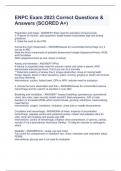ENPC Exam 2023 Correct Questions &
Answers (SCORED A+)
Preparation and traige - ANSWER1.State need for activation of trauma team
2. Prepare for trauma : ped equpment, length-based resuscitation tape and dosing
guidelines
3. State the need to don PPE
Across-the-room Observation - ANSWERAssess for uncontrolled hemorrhage (C), if
non go to ABC
State the three components of pediatric assessment triangle (Appeance/Airway, WOB,
and Circulation
AND categorizes them as sick, sicker or sickest
Airway and Alertness - ANSWER**APVU
If trauma is suspected state need for manual c-spine until collar is placed, AND
demonstrate manual jaw-thrust. If isn't you can do it normally
** Determine patency of airway (four): tongue obstruction, loose or missing teeth,
foreign objects, blood or other secretions, edem, snoring, gurgling or stridor and is there
any bony deformity
Interventions: suction, folded towel, OPA or NPA, indicate need for intubation
4. Across the room observation and then - ANSWERAssess for uncontrolled external
hemorrhage and the need to re prioritize C over ABC
Breathing and Ventilation. - ANSWER** Assess breathing: sponatenous, symmetrical
chest, skin color, open wounds, breath sounds? Subq empysema, JVD or trach
deviation or increased WOB (which would include, grunting, retractions, head bobbing,
nasal flaring)
Interventions: oxygen, ventilation, intubation, chest tube or needle thoracentesis
Circulation and hemorrhage - ANSWERAll of these: inspects of uncontrolled
hemorrhage, palpates central and peripheral pulses, inspect and palpates skins for
color, temp and moisture and assess cap refill
Interventions: control of hemorrhage, initiation chest compression, IV get two, cardiac
monitor if it is a dysrhythmia, fluid bolus 20mlkg - 10 mlkg for neonate or cardiogenic
shock
Disability - ANSWERGCS : verbal, eye and motor
Four score for unresponsive or intubated: eye, motor, brainstem and respiration status
PERRL
Interventions: glucose and if not need fo rintubation
, Exposure and Environment - ANSWERRemove all clothing AND inspect for
hemorrhage or other signs of illness or injuries
Interventions: warming lights. warm fluid, warmed oxygen, blankets
Full set of vitals - ANSWERVS and weight in KG
State need for family at bedside
Get adjuncts and give comfort - ANSWERLMNOP: Labs, monitor, naso/oro, pulse
oxmietry and ETCO2, assess pain using rFLACC, Nips or faces
Give comfort: repositioning, apply ice, caregiver, padding
What next - ANSWERdo they need to go to a high level of care or trauma center? Or
prep for surgery
History - ANSWERSAMPLE (symptoms, allegeries, meds, PMH, last oral, events and
environments
Haed to toe - ANSWERInspect and palpate head, face and neck chest for abnormalities
Listen to breath and lung sounds
Inspects abdoment and flanks, and listent
Palpates all four quadrants of abd
Inspects pelvics and perineum
Check illac crests and pubis symphysis
States indications and contraindications for catheters
Palpate and inspect all extremities
*Log roll patient and inspect back if there is any suspscion of spinal, pelvic or visceral
injury. Remove spinal board at this time
Reevaluation and post resuscitation care - ANSWERList at least three: imaging,
consults, abx, pain meds, social services, pysch, law enforcment, labs, wound care,
maintainence fluids (IV dextrose)
Reevaluate primary survey
Get another set of VS
Reevaluate pain
And double check abnormal findings and interentions
After this what is next - ANSWERsummarize all abnormal or known injuries
Definitive care or transport - ANSWERStates the need to transfer or admit to a facility
with pediatric resourcesPreparation and traige - ANSWER1.State need for activation of
trauma team
2. Prepare for trauma : ped equpment, length-based resuscitation tape and dosing
guidelines
3. State the need to don PPE




